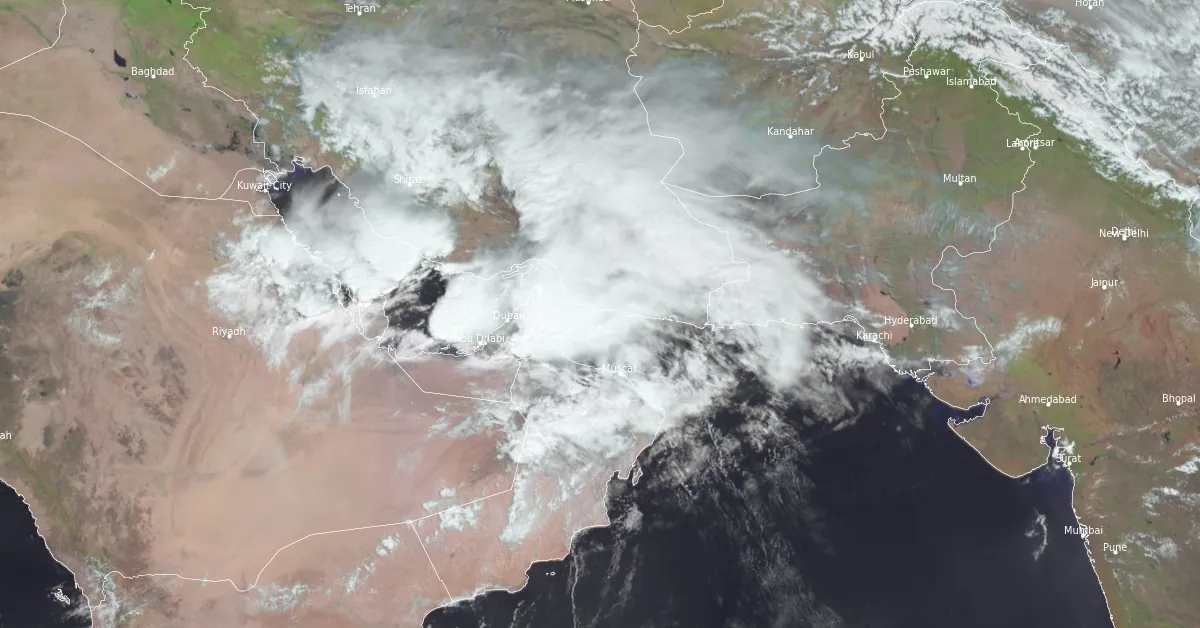Historic rainfall in UAE results in major flooding, traffic chaos in Dubai

On Tuesday, April 16, 2024, the UAE was struck by an exceptional weather event, with record-breaking rainfall reaching up to 254.8 mm (10 inches) in Al Ain, surpassing the country’s annual average in less than 24 hours. The National Centre of Meteorology (NMC) issued a red alert as the rains caused significant flooding, traffic disruptions, and at least one death in Dubai. This severe weather follows similar impacts in neighboring Oman, where 19 fatalities were reported.
A red alert was issued across the UAE on April 16 due to an extraordinary rainfall event that resulted in severe flooding, traffic chaos and one reported fatality. The affected areas include Dubai, where disruptions have been extensive, including at Dubai International Airport, recently recognized as the second-busiest globally. The airport experienced substantial flooding, causing significant operational challenges and flight delays.
The Khatm Al Shakla area in Al Ain recorded the highest rainfall, receiving 254.8 mm (10 inches) within 24 hours. This is the highest 24-hour rainfall in UAE since their record-keeping began in 1949. It’s also a figure that starkly contrasts with the UAE’s average annual rainfall of 140 – 200 mm (5.5 – 7.9 inches). Dubai typically receives about 97 mm (3.8 inches) annually, with April averages just around 8 mm (0.3 inches).
A downpour like this was last seen in Sharjah — and it happened before the unification of the seven emirates, Dr. Ahmed Habib of the NCM told Khaleej Times.
NMC data shows more than 50 stations have recorded rainfall higher than 100 mm (3.9 inches), and 4 stations have recorded rainfall higher than 200 mm (7.9 inches) from late Monday, April 15 to 22:00 LT on April 16.
In Dubai, footage emerged showing vast areas of the tarmac underwater, with large aircraft navigating through floodwaters. This resulted in the cancellation and delay of numerous flights, including all Flydubai flights until the morning of April 17. Emirates also suspended check-in operations, citing adverse weather and unsafe road conditions.
The torrential rain has led to widespread disruptions beyond the airport, affecting road traffic and public safety.
Sheikh Zayed Road, a major highway in Dubai, saw severe flooding, with dozens of vehicles submerged and significant traffic delays. This has prompted government actions, including remote work directives for federal employees in Dubai and Sharjah, and a closure directive for private schools.
Hundreds of people were stranded at Dubai Mall and Jebel Ali Metro Station, among other places.
Electricity and water supply interruptions were reported in various neighborhoods across Abu Dhabi and Dubai. Particularly, the Muroor Area in Abu Dhabi experienced a blackout for over an hour due to the heavy rains and strong winds.
A massive landslide struck the region of Al Qua in Al Ain, causing a gigantic crater-like collapse of a sandy road and significantly altering the course for drivers in the area.
Many people on social networks claimed that cloud-seeding operations exacerbated the rains, however, Dr. Habib said no cloud-seeding is done during extreme weather conditions.
The significant weather disturbance was primarily due to convective clouds forming over the region which triggered a series of weather events, leading to intense rainfall, he said.
Warm, moist air originating from the Arabian Sea moved towards Oman and the UAE, while low-pressure conditions were prevalent in the upper atmosphere. This scenario increased humidity levels in the UAE, further intensified by surface heating and cooling at higher altitudes. The condensation of moisture in the warm air, combined with these atmospheric conditions, resulted in highly unstable weather. Habib said the UAE experienced more than four distinct weather waves, with the most severe wave occurring from late Tuesday afternoon to late night, bringing about significant rainfall.
As the weather system continues to affect the region, a second wave of unstable weather began affecting the UAE on the afternoon of April 16, with forecasts predicting more heavy rain, thunderstorms, and potential hail through April 17. Authorities have advised residents to prepare for continued adverse conditions and to avoid unnecessary travel.
The same weather system impacted Oman over the past couple of days, leading to 19 fatalities.
According to the Ministry of Agriculture, Fisheries Wealth & Water Resources, Wadi Bani Khalid was the worst affected — with 145 mm (5.7 inches) of rainfall, followed by al Qabil with 91 mm (3.58 inches) in 24 hours to 08:00 LT on April 15.
References:
1 UAE witnesses record-breaking rains, highest in 75 years – Khaleej Times – April 16, 2024
2 As it happened: Rains disrupt Dubai Metro services, cause traffic diversions on Sheikh Zayed Road – Khaleej Times – April 17, 2024
3 UAE: Red alert issued as ‘hazardous’ weather intensifies across country – Khaleej Times – April 16, 2024
4 UAE’s NCM denies cloud-seeding rumours as emirates see heaviest rainfall on record – Khaleej Times – April 17, 2024
Featured image credit: EUMETSAT/Meteosat-9, RAMMB/CIRA, The Watchers. Acquired at 07:30 UTC on April 16, 2024



Commenting rules and guidelines
We value the thoughts and opinions of our readers and welcome healthy discussions on our website. In order to maintain a respectful and positive community, we ask that all commenters follow these rules.